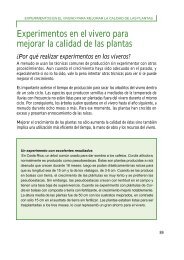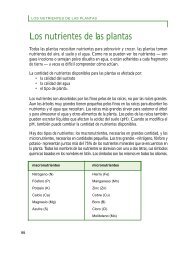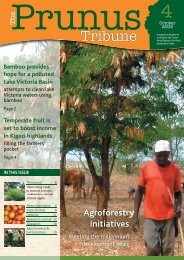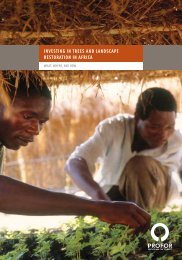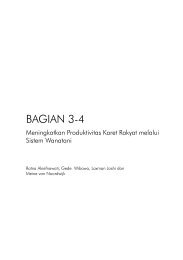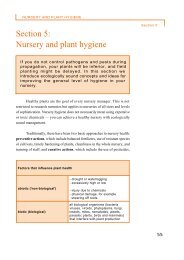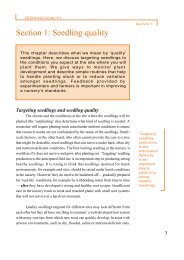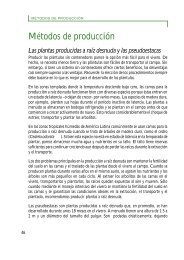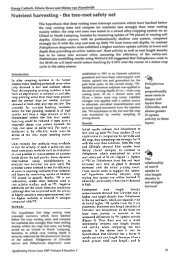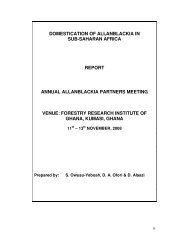- Page 2 and 3: AGROFORESTRY FOR SOIL CONSERVATION
- Page 4 and 5: CONTENTS Page Foreword iv Preface v
- Page 6 and 7: Foreword v development is now accep
- Page 8 and 9: ACKNOWLEDGEMENTS This review and pu
- Page 11 and 12: Chapter 1 Introduction Objectives T
- Page 13 and 14: Introduction 5 Environmental Data B
- Page 15: Landforms Introduction 1 In discuss
- Page 18 and 19: 10 Soil conservation and sustainabi
- Page 20 and 21: 12 Soil Conservation and Agroforest
- Page 23: Part II. Agroforestry for Control o
- Page 26 and 27: 18 Agroforestry for Control of Soil
- Page 28 and 29: 20 Agroforestry for Control of Soil
- Page 32 and 33: 24 Agroforestry for Control of Soil
- Page 34 and 35: 26 Agroforestry for Control of Soil
- Page 36 and 37: 28 Agroforestry for Control of Soil
- Page 38 and 39: 30 Agroforestry for Control of Soil
- Page 40 and 41: 32 Agroforestry for Control of Soil
- Page 42 and 43: 34 Agroforestry for Control of Soil
- Page 44 and 45: 36 Agroforestry for Control of Soil
- Page 46 and 47: 38 Agroforestry for Control of Soil
- Page 48 and 49: 40 Agroforestry for Control of Soil
- Page 50 and 51: 42 Agroforestry for Control of Soil
- Page 52 and 53: 44 Agroforestry for Control of Soil
- Page 54 and 55: 46 Agroforestry for Control of Soil
- Page 56 and 57: 48 Agroforestry for Control of Soil
- Page 58 and 59: 50 Agroforestry for Control of Soil
- Page 60 and 61: 52 Agroforestry for Control of Soil
- Page 62 and 63: 54 Agroforestry for Control of Soil
- Page 64 and 65: 56 Agroforestry for Control of Soil
- Page 66 and 67: 58 Agroforestry for Control of Soil
- Page 68 and 69: 60 Agroforestry for Control of Soil
- Page 70 and 71: 62 Agroforestry for Control of Soil
- Page 72 and 73: 64 Agroforestry for Control of Soil
- Page 74 and 75: 66 Agroforestry for Control of Soil
- Page 76 and 77: 68 Agroforestry for Control of Soil
- Page 78 and 79: 70 Agroforestry for Control of Soil
- Page 80 and 81:
72 Agmfarestry for Control of Soil
- Page 82 and 83:
74 Agro fores try for Control of So
- Page 84 and 85:
76 Agroforestry for Control of Soil
- Page 87:
Part HI. Agroforestry for Maintenan
- Page 90 and 91:
82 Agroforestry for Maintenance of
- Page 92 and 93:
84 Agroforestry for Maintenance of
- Page 94 and 95:
86 Agroforestry for Maintenance of
- Page 96 and 97:
88 Agroforestry for Maintenance of
- Page 98 and 99:
90 Agroforestry for Maintenance of
- Page 100 and 101:
92 Agroforestry for Maintenance of
- Page 102 and 103:
94 Agroforestry for Maintenance of
- Page 104 and 105:
96 Agroforestry for Maintenance of
- Page 106 and 107:
98 Agroforestry for Maintenance of
- Page 108 and 109:
100 Agroforestry for Maintenance of
- Page 110 and 111:
102 Agroforestry for Maintenance of
- Page 113 and 114:
Chapter 9 Soil Organic Matter Organ
- Page 115 and 116:
Soil organic matter 107 then, howev
- Page 117 and 118:
Soil organic matter 109 Table 17. E
- Page 119 and 120:
Figure 8. Decay curves for loss of
- Page 121 and 122:
Soil organic matter 113 Table 18. F
- Page 123 and 124:
Soil organic matter 115 half of dry
- Page 125 and 126:
Soil organic matter 117 split betwe
- Page 127 and 128:
Soil organic matter 119 Figure 11.
- Page 129 and 130:
Soil organic matter 121 dry season,
- Page 131 and 132:
Table 20 (cunt) Soil organic matter
- Page 133 and 134:
Soil organic matter 125 that are de
- Page 135 and 136:
Soil organic matter 127 branches an
- Page 137 and 138:
Chapter 10 Plant Nutrients Because
- Page 139:
Plant nutrients 131 Table 22. Nitro
- Page 142 and 143:
134 Agroforestry for Maintenance of
- Page 144 and 145:
136 Agroforestry for Maintenance of
- Page 146 and 147:
138 Agroforestry for Maintenance of
- Page 148:
Figure 14. Nitrogen and phosphorus
- Page 151:
Plant nutrients 143 Up to the prese
- Page 154 and 155:
146 Agroforestry for Maintenance of
- Page 156 and 157:
148 Agroforestry for Maintenance of
- Page 158 and 159:
150 Agroforestry for Maintenance of
- Page 160 and 161:
152 Agroforestry for Maintenance of
- Page 162 and 163:
154 Agroforestry for Maintenance of
- Page 164 and 165:
156 Agroforestry for Maintenance of
- Page 166 and 167:
158 Agroforestry for Maintenance of
- Page 168 and 169:
160 Agroforestry for Maintenance of
- Page 170 and 171:
162 Agroforestry for Maintenance of
- Page 172 and 173:
164 Agroforestry for Maintenance of
- Page 174 and 175:
166 Agroforestry for Maintenance of
- Page 176 and 177:
168 Agroforestry for Maintenance of
- Page 178 and 179:
170 Agroforestry for Maintenance of
- Page 180 and 181:
172 Agroforestry for Maintenance of
- Page 182 and 183:
174 Agroforestry for Maintenance of
- Page 184 and 185:
176 Agroforestry for Maintenance of
- Page 186 and 187:
178 Agroforestry for Maintenance of
- Page 188 and 189:
180 Agroforestry for Maintenance of
- Page 190 and 191:
182 Agroforestry for Maintenance of
- Page 192 and 193:
184 Agroforestry for Maintenance of
- Page 194 and 195:
186 Agroforestry for Maintenance of
- Page 196 and 197:
188 Agroforestry for Maintenance of
- Page 198 and 199:
190 Agroforestry for Maintenance of
- Page 200 and 201:
192 Agroforestry for Maintenance of
- Page 203:
Part IV. Agroforestry for Soil Cons
- Page 206 and 207:
198 Agroforestry for Soil Conservat
- Page 208 and 209:
200 Agroforestry for Soil Conservat
- Page 210 and 211:
Figure 17. Structure of the SCUAF c
- Page 212 and 213:
204 Agroforestry for Soil Conservat
- Page 214:
206 Agroforestry for Soil Conservat
- Page 217 and 218:
Modelling soil changes under agrofo
- Page 219:
Modelling soil changes under agrofo
- Page 222 and 223:
214 Agroforestry for Soil Conservat
- Page 224 and 225:
216 Agroforestry for Soil Conservat
- Page 226 and 227:
218 Agroforestry for Soil Conservat
- Page 228 and 229:
220 Agroforestry for Soil Conservat
- Page 230 and 231:
222 A grofores try for Soil Conserv
- Page 232 and 233:
224 Agroforestry for Soil Conservat
- Page 234 and 235:
226 Agroforestry for Soil Conservat
- Page 237 and 238:
Chapter 17 Conclusion Previous revi
- Page 239 and 240:
Conclusion 231 siderable potential
- Page 241 and 242:
SUMMARY The following is a summary
- Page 243 and 244:
Aspects of these recent trends sign
- Page 245 and 246:
Summary 237 other means (grass stri
- Page 247 and 248:
Summary 239 success of reclamation
- Page 249 and 250:
The role of roots Summary 241 There
- Page 251 and 252:
Summary 243 The presence of a given
- Page 253 and 254:
REFERENCES Abujamin. S. and Abujami
- Page 255 and 256:
References 247 Bernhard-Reversat, F
- Page 257 and 258:
References 249 Dalai, R.C. 1982. Or
- Page 259 and 260:
References 251 Ford, G.W., Greenlan
- Page 261 and 262:
References 253 Huxley. P.A. 1986a.
- Page 263 and 264:
References 255 Lal, R. 1980. Losses
- Page 265 and 266:
References 257 Miche, S. 1986. Acac
- Page 267 and 268:
References 259 Poore, M.E.D. and Fr
- Page 269 and 270:
References 261 Sanchez, PA. 1976. P
- Page 271 and 272:
References 263 Sumbcrg, .I.E. 1986.
- Page 273 and 274:
References 265 Wilkinson, G.E. 1975
- Page 275 and 276:
LIST OF ACRONYMS AND ABBREVIATIONS
- Page 277:
List of acronyms and abbreviations
- Page 280 and 281:
272 Index Colombia 58, 127 compost
- Page 282 and 283:
274 Index Melia uzedarach 160 Melia
- Page 284 and 285:
276 Index Tanzania 38, 54. 58, 120,
- Page 286 and 287:
I. INTRODUCTION II BACKGROUND (ID C
- Page 288 and 289:
- 2 - opinions. The best that can b
- Page 290 and 291:
The problem of the marketing of tro
- Page 292 and 293:
oic?e on a global basJLs^,J^rtrtryc
- Page 294 and 295:
- 8 - long-term interests to do so.
- Page 296 and 297:
- 10 - emergency measure, or should
- Page 298 and 299:
In addition, forests, by acting as
- Page 300 and 301:
- 14 - In all agrof ores try land m
- Page 302 and 303:
- 16 - as the crowding of tuberous
- Page 304 and 305:
- 18 - - their phyllotaxis should p
- Page 306 and 307:
- 2 0 - Leone, after the first brus
- Page 308 and 309:
Espacement In the vast majority of
- Page 310 and 311:
- 24 - Unfortunately there is very
- Page 312 and 313:
- 2€ - abl.o to pay their taxes r
- Page 314 and 315:
.imost exclusively, to agrisilvicul
- Page 316 and 317:
REFERENCES 1. Ahn, P.Mi (1970? - We
- Page 318:
- 32 - 36. Srivastava, B.P. and Pan






